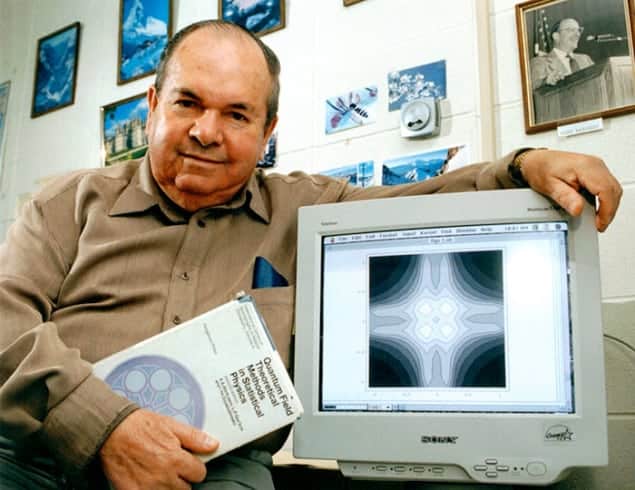Flash Physics is our daily pick of the latest need-to-know developments from the global physics community selected by Physics World‘s team of editors and reporters

Superconductivity pioneer Alexei Abrikosov dies at 88
The Nobel laureate Alexei Abrikosov has died at the age of 88. Born in Moscow in 1928, Abrikosov completed an undergraduate degree in physics at Moscow State University in 1948 before studying for a PhD in physics at the Institute for Physical Problems (IIP) in Moscow, graduating in 1951. Following a stint as a researcher at the IIP, in 1965 Abrikosov moved to the Landau Institute for Theoretical Physics until 1988. After two years as director of the Institute for High Pressure Physics, he then moved to Argonne National Laboratory in the US in 1991 where he remained for the rest of his career. Abrikosov made pioneering contributions to the theory of superconductivity. The theory of type-I superconductors – in which the material completely expels a magnetic field – was developed in the 1950s by the US scientists John Bardeen, Leon Cooper and Robert Schrieffer, for which the trio were awarded the Nobel Prize for Physics in 1972. Abrikosov together with Vitaly Ginzburg of the P N Lebedev Physical Institute in Moscow, developed a theory for “type-II” superconducting materials in which superconductivity and magnetism can co-exist. In 2003, Abrikosov shared the Nobel Prize for Physics together with Ginzburg and Anthony Leggett of the University of Illinois at Urbana “for their pioneering contributions to the theory of superconductors and superfluidity”.
SpaceX relaunches and lands a Falcon 9 rocket

A used Falcon 9 first stage has been successfully relaunched and landed as part of a recent SpaceX mission. In the past, rockets have traditionally been one use only. But in this case the segment had previously been used 11 months ago on a supply run to the International Space Station. The current mission, launched from Florida’s Kennedy Space Center in the US at 18:27 EDT on 30 March, saw it assist in delivering SES-10, a commercial communications satellite, into geostationary orbit. The rocket segment was also successfully landed on a barge in the Atlantic. Containing nine Merlin engines and aluminium-lithium alloy tanks of liquid oxygen and rocket-grade kerosene propellant, the first stage represents about 80% of a Falcon 9 launch cost. Therefore, the successful relaunch and recovery is an important milestone for SpaceX and may lead to significant cost savings. “This is going to be, hopefully, a huge revolution in spaceflight,” says SpaceX chief executive Elon Musk. Although NASA’s space-shuttle system was partially reusable, the SpaceX mission is the world’s first re-flight of an orbital class rocket.
Long nanotubes are excellent heat conductors
The thermal conductivity of singled-walled carbon nanotubes (SWCNTs) increases with their length on scales of several millimetres, according to physicists in Taiwan. Carbon nanotubes have walls that are just one atom thick and it was already known that their thermal conductance increases with length on microscopic scales. This contradicts Fourier’s law of heat conduction, which says that the thermal conductivity is an intrinsic material property that is independent of the shape of a sample. Calculations had suggested that the thermal conductivity of defect-free SWCNTs would increase up to millimetre lengths, however it has been very difficult to both calculate and measure conductivities of long SWCNTs. Now, Victor Lee, Chih-Wei Chang and colleagues at the National Taiwan University in Taipei have come up with a way of measuring the thermal conductivity of SWCNTs with lengths between 4 μm and 1.039 mm. They found that the thermal conductivity increases with the length of the SWCNT and that some 1 mm long samples had conductivities that are approximately four times higher than diamond or graphene – materials that are both known for their very high thermal conductivity. The physicists say that their findings suggest that the heat-carrying capacity of long-wavelength lattice vibrations (phonons) play an important role in the thermal properties of low-dimensional systems such as SWCNTs. The result, which is reported in Physical Review Letters, could lead to the development of high-effective heat-management systems for tiny systems such as computer chips.
- You can find all our daily Flash Physics posts in the website’s news section, as well as on Twitter and Facebook using #FlashPhysics. Tune in to physicsworld.com later today to read today’s extensive news story on a new silicon qubit.



